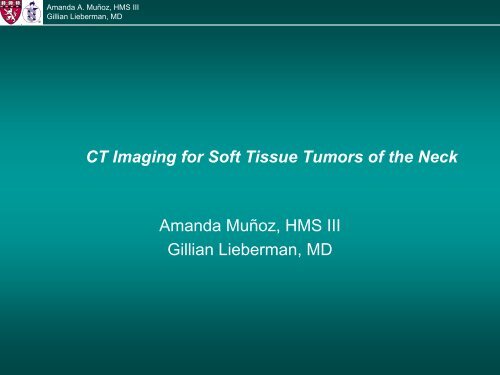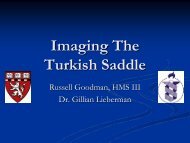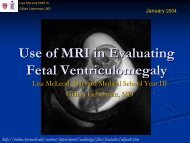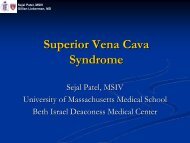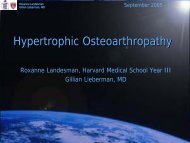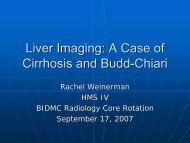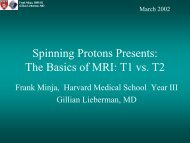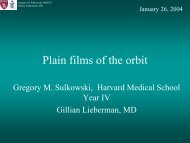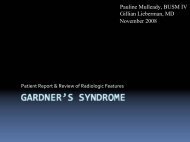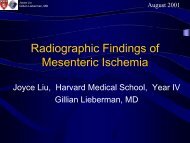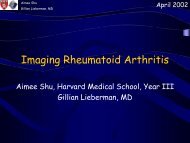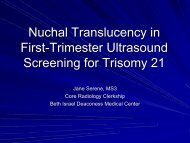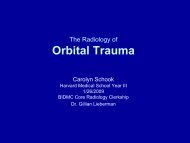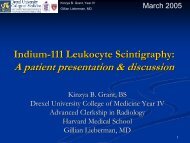CT Imaging for Soft Tissue Tumors of the Neck
CT Imaging for Soft Tissue Tumors of the Neck
CT Imaging for Soft Tissue Tumors of the Neck
Create successful ePaper yourself
Turn your PDF publications into a flip-book with our unique Google optimized e-Paper software.
Amanda A. Muñoz, HMS III<br />
Gillian Lieberman, MD<br />
<strong>CT</strong> <strong>Imaging</strong> <strong>for</strong> <strong>S<strong>of</strong>t</strong> <strong>Tissue</strong> <strong>Tumors</strong> <strong>of</strong> <strong>the</strong> <strong>Neck</strong><br />
Amanda Muñoz, HMS III<br />
Gillian Lieberman, MD
Amanda A. Muñoz, HMS III<br />
Gillian Lieberman, MD Overview<br />
• An introduction via <strong>the</strong> case <strong>of</strong> our patient CB<br />
• The Menu <strong>of</strong> Tests available to evaluate a neck mass<br />
• An overview <strong>of</strong> neck anatomy<br />
• The DDx <strong>of</strong> s<strong>of</strong>t tissue masses in <strong>the</strong> neck<br />
• Radiographic characteristics <strong>of</strong> neck masses<br />
• Examples <strong>of</strong> various neck masses from different<br />
patients<br />
• Examination <strong>of</strong> CB’s scan<br />
• A word about CB’s findings<br />
2
Amanda A. Muñoz, HMS III<br />
Gillian Lieberman, MD Beginning with “Our Patient” CB<br />
• 51yo M h/o HTN, chol p/w R tongue lesion 1/04<br />
• Bx 2/04 c/w metastatic clear cell renal carcinoma<br />
• <strong>CT</strong> <strong>of</strong> neck, thorax, abdomen per<strong>for</strong>med <strong>for</strong> staging<br />
– 12 x 10 cm R renal mass with R renal vein clot<br />
– 2 nodules in <strong>the</strong> L lingula<br />
– Enlarged lymph nodes: cervical, pretracheal, hilar, pericaval,<br />
periaortic, retrocaval, retroperiotneal<br />
– Assymmetry <strong>of</strong> <strong>the</strong> oropharynx and hypopharynx w/o<br />
definable mass<br />
• Normal liver, spleen, adrenals, pancreas<br />
• No bony lytic or sclerotic lesions<br />
• Brain MRI negative <strong>for</strong> any intracranial metastases<br />
3<br />
Courtesy Dr. David Hackney
Amanda A. Muñoz, HMS III<br />
Gillian Lieberman, MD<br />
More about CB<br />
• R radical nephrectomy and lymphadenectomy 2/04<br />
• pathology c/w clear cell carcinoma <strong>of</strong> <strong>the</strong> kidney<br />
• recovered well from surgery<br />
• presents to BIDMC 5/04 to explore treatment options<br />
• Denies recent F/C/NS, N/V/D, CP, SOB, flank pain, hematuria,<br />
dysuria, edema, neurologic sx. Does report 8 lb weight loss<br />
over 1 month.<br />
4<br />
Courtesy Dr. David Hackney
Amanda A. Muñoz, HMS III<br />
Gillian Lieberman, MD<br />
• no palpable LAD<br />
• Palpable mass in <strong>the</strong> R anterior neck<br />
• CN II-XII intact<br />
<strong>CT</strong> scan per<strong>for</strong>med to evaluate extent <strong>of</strong><br />
current disease <strong>for</strong> <strong>the</strong>rapy guidance<br />
CB’s Physical Exam<br />
5<br />
Courtesy Dr. David Hackney
Amanda A. Muñoz, HMS III<br />
Gillian Lieberman, MD The Menu <strong>of</strong> Tests <strong>for</strong> <strong>Neck</strong> <strong>Imaging</strong><br />
<strong>CT</strong><br />
Modality Utility<br />
Most effective <strong>for</strong> tissue discrimination,<br />
spatial resolution, staging, mass effect,<br />
treatment planning, monitoring response<br />
Ultrasound Characterize cystic or vascular masses<br />
Angiography Pre-op embolization<br />
PET/radio-<br />
nuclide scans<br />
MRI<br />
Image neoplasms, thyroid nodules<br />
Difficult discrimination between neoplasm and<br />
normal tissue<br />
CXR Not used <strong>for</strong> diagnosis<br />
Eskey, Rad Clin N Am, p. 1091<br />
6
SCMs<br />
Amanda A. Muñoz, HMS III<br />
Gillian Lieberman, MD Triangles <strong>for</strong> Clinicians<br />
Clinicians use <strong>the</strong> following triangles to navigate neck anatomy:<br />
Anterior Triangle<br />
bjj.org/articles/ 971008-revive/<br />
Mandible<br />
Hyoid Bone<br />
•The neck is a cylinder extending<br />
from <strong>the</strong> mandible to <strong>the</strong> thoracic<br />
inlet and from <strong>the</strong> base <strong>of</strong> <strong>the</strong> skull<br />
to <strong>the</strong> scapulae<br />
•The anterior triangle <strong>of</strong> <strong>the</strong> neck is<br />
bordered by <strong>the</strong> SCMs and <strong>the</strong><br />
mandible<br />
•The anterior triangle is divided into<br />
<strong>the</strong> suprahyoid and infrahyoid<br />
regions by <strong>the</strong> hyoid bone<br />
•The infrahyoid region is divided<br />
into <strong>the</strong> carotid and muscular<br />
triangles by <strong>the</strong> superior belly <strong>of</strong> <strong>the</strong><br />
omohyoid muscle<br />
•The carotid triangle contains <strong>the</strong><br />
carotid sheath<br />
7
Amanda A. Muñoz, HMS III<br />
Gillian Lieberman, MD<br />
•The posterior triangle is<br />
bordered by <strong>the</strong> SCMs,<br />
trapezius and clavicle<br />
•The inferior belly <strong>of</strong> <strong>the</strong><br />
omohyoid muscle divides <strong>the</strong><br />
posterior triangle into <strong>the</strong><br />
superior and inferior regions<br />
•The inferior region <strong>of</strong> <strong>the</strong><br />
posterior triangle contains <strong>the</strong><br />
subclavian artery and <strong>the</strong><br />
brachial plexus<br />
Triangles <strong>for</strong> Clinicians<br />
Posterior Triangle<br />
www.ptjournal.org/.../ v81n3p936-figs.cfm<br />
8
Amanda A. Muñoz, HMS III<br />
Gillian Lieberman, MD Spaces <strong>for</strong> Radiologists<br />
Radiologists use “spaces”, not triangles, to describe <strong>the</strong> neck<br />
•The spaces <strong>of</strong> <strong>the</strong> neck are defined by <strong>the</strong><br />
cervical fascia<br />
•The hyoid bone again divides <strong>the</strong> neck into<br />
two regions<br />
Suprahyoid spaces<br />
Submandibular<br />
• Submandibular –<br />
below <strong>the</strong> mandible<br />
and floor <strong>of</strong> <strong>the</strong> mouth<br />
• Visceral – containing<br />
<strong>the</strong> pharynx, larynx,<br />
Parapharyngeal<br />
trachea, glands<br />
Visceral<br />
• Parapharyngeal –<br />
surrounding <strong>the</strong><br />
pharynx<br />
9<br />
http://iris3.med.tufts.edu/headneck
Amanda A. Muñoz, HMS III<br />
Gillian Lieberman, MD Spaces <strong>for</strong> Radiologists<br />
Radiologists use “spaces”, not triangles, to describe <strong>the</strong> neck<br />
Infrahyoid Spaces<br />
• Investing –<br />
superficial,<br />
containing<br />
musculature<br />
• Visceral –<br />
containing organs,<br />
larynx, pharynx,<br />
trachea,<br />
cartilages, glands<br />
• Prevertebral –<br />
spinal column and<br />
surrounding<br />
musculature<br />
Investing<br />
Prevertebral<br />
Visceral<br />
10<br />
http://iris3.med.tufts.edu/headneck
Amanda A. Muñoz, HMS III<br />
Gillian Lieberman, MD <strong>Neck</strong> Masses: Types<br />
<strong>S<strong>of</strong>t</strong> tissue masses like CB’s can be <strong>of</strong> many etiologies:<br />
• Superficial/Subcutaneous: sebaceous cysts, cellulitis<br />
• Salivary Gland: benign and malignant enlargement<br />
• Thyroid and Parathyroid: benign and malignant enlargement<br />
• Aerodigestive Tract: SCC, cysts<br />
• Vascular: mal<strong>for</strong>mations<br />
• Neurogenic: glomus tumors<br />
• <strong>S<strong>of</strong>t</strong> <strong>Tissue</strong> Lesions<br />
DDx<br />
– Abscess<br />
– Lymphadenopathy (benign, metastatic)<br />
– Lymphoma<br />
– Salivary Gland Enlargement<br />
– Thyroid: adenoma, goiter, cyst, carcinoma<br />
– Branchial cleft cyst<br />
– Lipoma<br />
– O<strong>the</strong>r (e.g., vascular, neurogenic, sarcoma, thyroglossal duct cyst)<br />
www.ptjournal.org/.../ v81n3p936-figs.cfm<br />
Gamuts in Radiology<br />
11
Amanda A. Muñoz, HMS III<br />
Gillian Lieberman, MD<br />
• Fat density<br />
• Fluid-fluid levels<br />
• Fascial planes<br />
• Size<br />
• Deep vs. superficial<br />
• Intramuscular<br />
• Necrosis<br />
• Hemorrhage<br />
• Margins<br />
<strong>Neck</strong> Masses: Radiographic Characteristics<br />
The following should be evaluated when imaging s<strong>of</strong>t tissue neck<br />
masses:<br />
12<br />
Eskey, Rad Clin N Am, p.1092
Amanda A. Muñoz, HMS III<br />
Gillian Lieberman, MD Some Examples from our differential….<br />
• The following slides show examples <strong>of</strong> various types<br />
<strong>of</strong> neck masses<br />
• Each mass should be evaluated according to <strong>the</strong><br />
radiographic characteristics listed on <strong>the</strong> previous<br />
slide<br />
• We will end with a look back at our patient CB’s <strong>CT</strong> <strong>of</strong><br />
<strong>the</strong> neck to see if it shares any <strong>of</strong> <strong>the</strong> characteristics<br />
<strong>of</strong> <strong>the</strong> o<strong>the</strong>r examples <strong>of</strong> neck masses<br />
13
Amanda A. Muñoz, HMS III<br />
Gillian Lieberman, MD Abscess<br />
•This mass is in <strong>the</strong> anterior triangle and <strong>the</strong> parapharyngeal space<br />
•It has no fat density, fluid-fluid levels, it is within a Fascial plane, <strong>of</strong> large Size, Deep, not intramuscular,<br />
does show evidence <strong>of</strong> Necrosis, no Hemorrhage<br />
•Difficult to see its margins because it is <strong>of</strong> similar density to <strong>the</strong> surrounding muscle<br />
Normal <strong>CT</strong> Retropharyngeal Abscess<br />
PACS, BIDMC<br />
Abscess<br />
http://rad.usuhs.mil/medpix/medpix.html?mode<br />
=geo_browse&table=card&expand=75<br />
14
Amanda A. Muñoz, HMS III<br />
Gillian Lieberman, MD Lymphadenopathy<br />
•This mass is in <strong>the</strong> posterior triangle and <strong>the</strong> prevertebral space<br />
•It has no fat density, fluid-fluid levels, it is within a fascial plane, large Size, deep, not intramuscular, does<br />
show evidence <strong>of</strong> Necrosis with ? Extension into <strong>the</strong> temporalis, no Hemorrhage, Margins here appear<br />
visible<br />
Normal <strong>CT</strong><br />
Necrotic Lymphadenitis<br />
Lymph<br />
Node<br />
PACS, BIDMC Courtesy Dr. Atif Zaheer<br />
15
Amanda A. Muñoz, HMS III<br />
Gillian Lieberman, MD Thyroid<br />
•This mass is in <strong>the</strong> anterior triangle and <strong>the</strong> visceral space<br />
•It has no fat density, no fluid-fluid levels, it is within a fascial plane and limited to thyroid, enlarged Size,<br />
superficial, not Intramuscular, no Necrosis or Hemorrhage, good Margins. ? nodes.<br />
•well-enhancing due to vascular nature <strong>of</strong> gland, even w/o contrast due to Iodine content!<br />
Normal <strong>CT</strong><br />
Multi-Nodular Goiter<br />
Thyroid<br />
Nodules<br />
PACS, BIDMC PACS, BIDMC<br />
16
Amanda A. Muñoz, HMS III<br />
Gillian Lieberman, MD Cystic<br />
•This lesion is in <strong>the</strong> anterior triangle and <strong>the</strong> investing vs parapharyngeal space<br />
•It is well circumscribed, does not appear to have fat density, no fluid-fluid levels, is within a fascial plane, is<br />
superficial, large, and no evidence <strong>of</strong> necrosis or hemorrhage. HU = fluid.<br />
Normal <strong>CT</strong><br />
PACS, BIDMC<br />
Cyst<br />
Branchial Cleft Cyst<br />
Courtesy Dr. Atif Zaheer<br />
17
Amanda A. Muñoz, HMS III<br />
Gillian Lieberman, MD Lipomatous<br />
•This lesion is in <strong>the</strong> Anterior triangle, investing space<br />
•Circumscribed, smooth, uni<strong>for</strong>m attenutation. -65 to -125 HU, thin fibrous septa, does not enhance w/ IV<br />
contrast<br />
Normal <strong>CT</strong><br />
PACS, BIDMC<br />
Submandibular Lipoma<br />
Lipoma<br />
www.aichi-gauin.ac.ip/.../NB122.htm<br />
18
Amanda A. Muñoz, HMS III<br />
Gillian Lieberman, MD CB<br />
CB scan showed left thyroid enlargement and right-sided<br />
lymphadenopathy<br />
Lymph nodes<br />
Thyroid mass w/<br />
tracheal compression<br />
•Anterior triangle, visceral space. Nodes are anterior and parapharyngeal.<br />
•left lobe enlargment to 48mm, appears hypodense <strong>for</strong> a thyroid though pt has not yet gotten contrast.<br />
•Mass is heterogenous with cyst <strong>for</strong>mation on both sides, even though R is not as large as <strong>the</strong> left<br />
•R sided LAD (level 5), some with central hypodensity that may indicate necrosis, size and mutliplicity <strong>of</strong> nodes (also level 192<br />
and<br />
3)suggest malignancy<br />
Courtesy Dr. David Hackney<br />
•Displacement <strong>of</strong> trachea to L
Amanda A. Muñoz, HMS III<br />
Gillian Lieberman, MD RCC and Thyroid Metastases<br />
<strong>CT</strong> findings could be consistent with <strong>the</strong> following:<br />
• Goiter with nodal mets<br />
• Primary thyroid malignancy w/ nodal mets<br />
• Metastatic disease involving both thyroid and nodes<br />
• Metastasis to thyroid gland is a very rare cause <strong>of</strong> thyroid enlargement<br />
• Vascular supply may result in entrapment <strong>of</strong> tumor emboli<br />
• Usually nodular, ei<strong>the</strong>r single or multiple<br />
• Can mimic primary thyroid gland neoplasms or multinodular goiter<br />
• RCC is one <strong>of</strong> <strong>the</strong> most common types <strong>of</strong> cancer to metastasize to <strong>the</strong><br />
thyroid<br />
– O<strong>the</strong>rs include melanoma, breast, lung, colon<br />
– SCC local invasion<br />
• When thyroid mets are <strong>the</strong> first clinical presentation, <strong>the</strong> primary is most<br />
<strong>of</strong>ten RCC<br />
20<br />
Hefess, Metastatic RCC
Amanda A. Muñoz, HMS III<br />
Gillian Lieberman, MD Summary<br />
• <strong>CT</strong> scan is <strong>the</strong> modality <strong>of</strong> choice <strong>for</strong> tissue<br />
differentiation, staging and monitoring treatment <strong>of</strong><br />
neck pathology<br />
• <strong>Neck</strong> anatomy is divided into triangles or spaces<br />
• <strong>Neck</strong> masses may arise from many tissues <strong>of</strong> <strong>the</strong><br />
neck<br />
• <strong>S<strong>of</strong>t</strong> tissue neck masses have few specific<br />
radiographic characteristics but many hints can point<br />
<strong>the</strong> radiologist toward a benign or malignant process<br />
• <strong>CT</strong> may not be able to delineate <strong>the</strong> origin <strong>of</strong> a neck<br />
mass!<br />
21
Amanda A. Muñoz, HMS III<br />
Gillian Lieberman, MD References<br />
• Branstetter, BF and Weissman JL. Normal Anatomy <strong>of</strong> <strong>the</strong> <strong>Neck</strong> with <strong>CT</strong> and MR <strong>Imaging</strong><br />
Correlation. Radiologic Clinics <strong>of</strong> North America; Sept 2000 38:925-940.<br />
• Eskey, CJ, Robson, CD, Weber AL. <strong>Imaging</strong> <strong>of</strong> Benign and Mailgnant <strong>S<strong>of</strong>t</strong> <strong>Tissue</strong> <strong>Tumors</strong> <strong>of</strong><br />
<strong>the</strong> <strong>Neck</strong>. Radiologic Clinics <strong>of</strong> North America; Sept 200, 38:1091-1104.<br />
• Gottlieb MD, Roland JT. Paradoxical spread <strong>of</strong> renal cell carcinoma to <strong>the</strong> head and neck.<br />
Laryngoscopy; Sept 1998: 1301-5.<br />
• Hefess, CS, Wenig, BM, Thompson LD. Metastatic Renal Cell Carcinoma to <strong>the</strong> Thyroid<br />
Gland. Cancer; November 1 2002: 1869-1878<br />
• Kazuhiro A, Hasegawa T, Onodera S, Oishi Y, Suzuki M. Renal Metastasis <strong>of</strong> Thyroid<br />
Carcinoma. International Journal <strong>of</strong> Urology; 2002 (9): 656-658.<br />
• Larson SM, Robbins R. Positron emission tomography in thyroid cancer management.<br />
Seminars in Roentgenology; Apr 2002: 169-74.<br />
• Lev S, Lev MH. <strong>Imaging</strong> <strong>of</strong> Cystic Lesions. Rad Clin N Am; Sept 2000; 38:1013-1029.<br />
• Pickhardt, PJ, Pickard RH. Sonography <strong>of</strong> delayed thyroid metastasis from renal cell<br />
carcinoma with jugular vein extension. American Jounral or Roentgenology; Jul 2003: 272-4.<br />
• Sakai, O, et al. Lymph Node Pathology: Benign Proliferative, Lymphoma and Metastatic<br />
Disease. Rad Clin N AM; Sept 2000; 38: 979-999.<br />
• Som, PM, et al. Head and <strong>Neck</strong> <strong>Imaging</strong>. Mosby; 1991: 498-669.<br />
• Weber, AL, Randolph G, Aksoy FG. The Thyroid and Parathyroid Glands: <strong>CT</strong> and MR <strong>Imaging</strong><br />
and Correlation with Pathology and Clinical Findings. Radiologic Clinics <strong>of</strong> North America;<br />
Sept 2000, 38:1105-1130.<br />
• Weber, AL, Siciliano, A. <strong>CT</strong> and MR <strong>Imaging</strong> <strong>of</strong> <strong>Neck</strong> Infections with Clinical Correlations. Rad<br />
Clin <strong>of</strong> N Am; Sept 2000; 38:941-969.<br />
22
Amanda A. Muñoz, HMS III<br />
Gillian Lieberman, MD Acknowledgements<br />
• My May 2004 Core Radiology Classmates<br />
• Pamela Lepkowski<br />
• Gillian Lieberman, MD<br />
• Dr. David Hackney<br />
• Dr. Michael Schuster<br />
• Dr. Atif Zaheer<br />
• Larry Barbaras our Webmaster<br />
• Michael Levinson<br />
23


